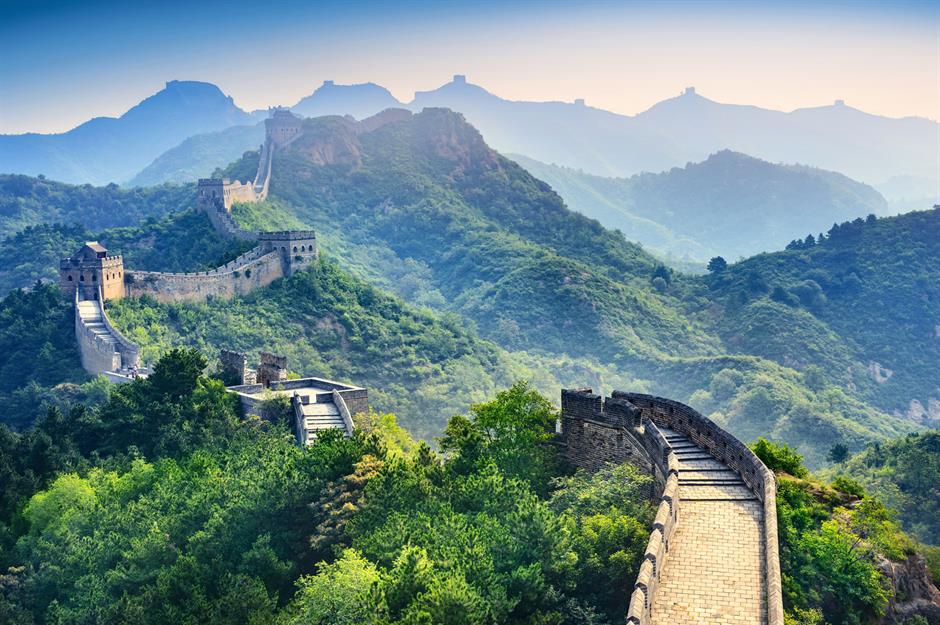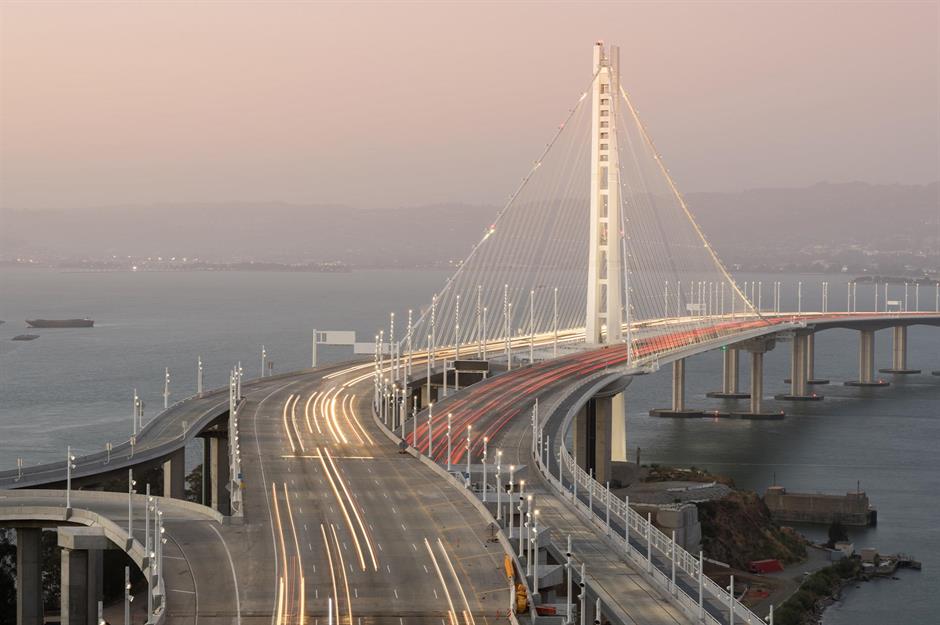History's most expensive megaprojects, from China's Great Wall to the US interstate

Aphotostory/Shutterstock
Humanity's costliest construction endeavours
The human race has been making its mark on the planet since time immemorial, embarking on ever more ambitious, and expensive, constructions. The costliest run into tens and even hundreds of billions of dollars, and range from spectacular new cities to immense road and rail networks. From China's Great Wall to the US highway system, click or scroll through the 20 most expensive completed megaprojects of all time, adjusted for inflation into today's money, and get ready for your jaw to drop.

yhelfman/Shutterstock
San Francisco-Oakland Bay Bridge Eastern Span, US: $7.3 billion (£5.2bn)
The Bay Bridge, as it's also known, is actually two bridges connected at Yerba Buena Island. Original constructed in the 1930s, it opened in 1936. The west connects to San Francisco, and the east connects to Oakland. However, this eastern span was damaged during the 1989 Loma Prieta earthquake when a section of the upper deck collapsed onto the lower deck, showing the 1930s bridge's fragility. The incident led to the death of one person. The authorities eventually decided to build a new bridge for the eastern section, featuring a 525-foot-tall single-tower with self-anchored suspension. The work started in 2006, and the bridge opened in 2013 at an estimated cost of $6.4 billion (£4.3bn), more than six times the planned budget. In today's money that's $7.3 billion (£5.2bn). Then the original structure needed to be demolished; the work, priced around $239 million (£158m), took three years, often in close proximity of moving traffic.
DENIS CHARLET/Getty Images
The Channel Tunnel, UK and France: $13.4 billion (£9.5bn)
The Channel Tunnel connects England and France, and enables cars to board a train and travel beneath the English Channel from one country to the other in just 35 minutes. The project was 80% over budget by the time it opened in 1994, and cost £4.65 billion ($6.9bn), which is the equivalent of £9.5 billion ($13.4bn) today. The tunnel only became profitable in 2011, 17 years after it opened. It has the longest underwater section of any tunnel in the world at 23.5 miles (37.8km).
Great Seto Bridge, Japan: $15.8 billion (£11.2bn)
Japan's Great Seto Bridge, also known as Seto Ohashi Bridge, spans five islands in the Seto Inland Sea, stretching a total of 8.1 miles (13.1km), which makes it the longest two-tier bridge in the world. Opened in 1988, the bill for the crossing was $7 billion (£3.9bn), which is equivalent to an eye-watering $15.8 billion (£11.2bn) in today's money.
Hong Kong-Zhuhai-Macau Bridge, Hong Kong/China/Macau: $20 billion (£15.2bn)
This 34-mile (55km) megaproject, which was completed two years behind schedule in 2018, connects Hong Kong, mainland China and Macau, and consists of three bridges and a tunnel. It is the world's longest sea-crossing bridge. The megaproject also takes the title of the most expensive bridge and tunnel complex ever, after it cost a jaw-dropping $20 billion (£15.2bn). It’s unsurprising that the final bill was such a big sum, as an enormous 400,000 tonnes of steel went into building it – the equivalent of 60 Eiffel Towers.
Darren McCollester/Newsmakers/Getty
Big Dig, USA: $24.3 billion (£18.7bn)
The Big Dig involved redirecting the highway that passes through the centre of Boston into a 3.5-mile (5.6km) tunnel, and the construction of additional tunnels and a bridge. Needless to say, the 15-year project, which began in 1992, was insanely expensive – the final bill will likely reach a staggering $24.3 billion (£18.7bn), with payments set to continue until 2038.
Kansai International Airport, Japan: $24.8 billion (£17.6bn)
Completed in 1994, Japan's Kansai International Airport was built on an artificial island in Osaka Bay, which has been beset by subsidence problems since its construction. By 2008, the final bill for the airport had mushroomed to $20 billion (£20bn), which is $24.8 billion (£17.6bn) in today's prices, with much of the money spent on shoring up the sinking island.
Toei Oedo Line, Japan: $28.5 billion (£20.1bn)
Boasting 38 stations, this major subway line in Tokyo was completed in December 2000 at a cost of $18.4 billion (£11.6bn), which is the equivalent of $28.5 billion (£20.1bn) in today’s money, making it Japan’s most expensive subway line. The fully underground line runs in a loop around the centre of Tokyo, before branching out into the western suburbs of the city.
Phillip Kraskof/Shutterstock
Hong Kong International Airport, China: $32.8 billion (£23.2bn)
The construction of Hong Kong's International Airport, which was completed in 1998, involved reclaiming 3.7 square miles (9.6 square km) of land around the island of Chek Lap Kok, which considerably added to the final bill and increased Hong Kong’s landmass by 1%. The total cost of $20 billion (£12.1bn) works out at around $32.8 billion (£23.2bn) in today's money.
Courtesy Moarplease/Flickr CC
Trans-Alaska Pipeline System, USA: $35.2 billion (£24.9bn)
The Trans-Alaska Pipeline system was built between 1974 and 1977 at a cost of $8 billion (£4.7bn), an enormous amount of cash at the time, which would be $35.2 billion (£24.9bn) today. Massively important to the Alaskan economy, the 800-mile (1,287km) pipeline was instrumental in facilitating the growth of the state's oil industry.
Beijing–Shanghai High-Speed Railway, China: $41.2 billion (£29.2bn)
China's most profitable high-speed railway commenced operations in 2011. The 819-mile (1,318km) railway is the longest high-speed line constructed in a single phase and carries over 130 million passengers a year. Needless to say, the line didn't come cheap – all in all, a total of $34.7 billion (£21.3bn) was invested in the project. That's the equivalent of $41.2 billion (£29.2bn) in 2021.
Yas Island, UAE: $42.5 billion (£30bn)
Abu Dhabi's premier entertainment and leisure district, Yas Island boasts climate-controlled theme parks including Ferrari World and Warner Bros. World, luxury hotels, a concert venue that seats 35,000, a huge shopping mall, and more besides. Completed in 2018, the $40 billion (£29bn) development is set to grow further with several additional attractions, including a SeaWorld aquarium. The cost to build it is the equivalent of $42.5 billion (£30bn) today.
Three Gorges Dam, China: $43.4 billion (£30.6bn)
The world's largest and most expensive hydro-power project, China's Three Gorges Dam was completed in 2012 at a cost of $37.2 billion (£23.3bn), considerably over budget. That's the equivalent of $43.4 billion (£30.6bn) today. The final bill included relocating 1.3 million people who were displaced by the dam, which is so big it has literally slowed the rotation of the planet thanks to all the water it moves around.
Stefano Ember/Shutterstock
Itaipu Dam, Brazil/Paraguay: $50.4 billion (£35.6bn)
Completed in 1984 at a cost of $19.6 billion (£13.1bn), the hydroelectric Itaipu Dam on the border of Brazil and Paraguay provides Brazil with 20% of its energy needs and Paraguay with over 75%. The hydroelectric project is considered one of the world's most ambitious, and has been described as being among the modern Seven Wonders of the World by the American Society of Civil Engineers. Adjusting for inflation, in today's money the dam would cost $50.4 billion (£35.6bn) to build.
Ovchinnikova Irina / Shutterstock
Sochi Olympic Stadium, Russia: $51 billion (£42.2bn)
Why did the Sochi Olympics cost 325% more than budgeted, setting Russian taxpayers back $51 billion (£42.2bn)? In a word: corruption. This was the most expensive – and controversial – Olympics in history due to corruption being endemic in the Russian construction industry. Two members of the opposition party, Leonid Martynyuk and Boris Nemtsov, claimed in a 2013 report that up to $30 billion (£24.8bn) of the budget had gone missing in "kickbacks and embezzlement" to President Putin's close associates.
Honshu-Shikoku Bridge Project, Japan: $76.9 billion (£54.4bn)
This system of three expressways and 18 bridges, which connects the islands of Honshu and Shikoku, was completed in 1999 and remains Japan's biggest and most expensive realised construction project. The final bill for the mammoth project stood at $48 billion (£29.8bn) in 1999, around $76.9 billion (£54.4bn) in today's dollars when adjusted for inflation.
International Space Station: $169 billion (£119.6bn)
The International Space Station is estimated to have cost $150 billion (£97bn) as of 2015. The space station, which shines brighter than Venus in the night sky, is a joint project among five participating space agencies: America's NASA, Russia's Roscosmos, Japan's JAXA, Europe's ESA, and Canada's CSA.
Sony Herdiana/Shutterstock
Masjid al-Haram, Saudi Arabia: $200 billion (£141bn)
The world's largest mosque and Islam's most sacred site, the Masjid al-Haram in Mecca covers 99 acres and can accommodate up to four million pilgrims during the Hajj. The total cost of construction and maintenance of the holy building has been estimated at an incredible $100 billion (£77.7bn), and Saudi Arabia is planning to spend another $100 billion (£77.7bn) on the site in the coming years.
Kashagan Field, Kazakhstan: $217.5 billion (£153.7bn)
Construction of this offshore oil field in the Caspian Sea in Kazakhstan kicked off in 2001 but oil production didn't commence until 2013. The oil field sits in shallow, hydrogen sulphide-rich waters that freeze over in winter, making it one of the most challenging – and expensive – engineering projects of all time. Reports vary as to how much the megaproject actually cost, but offshore-technology.com suggests it cost as much as $187 billion (£117bn), the equivalent of $217.5 billion (£153.7bn) in today's money.
Great Wall of China: $360 billion (£255bn)
Stretching over 13,171 miles, the Great Wall of China dates back more than 2,300 years and took over 2,000 years to complete. Millions of workers toiled away constructing the remarkable architectural feat which, contrary to popular belief, isn't actually visible from space. Exactly how much it cost in today's money is open to question, but an upper estimate of $360 billion (£271.9bn) has been suggested.
Roschetzky Photography/Shutterstock
Interstate Highway System, US: $563 billion (£398bn)
Construction of America's Interstate Highway System began in June 1959 and the enormous network of freeways now stretches more than 47,856 miles. The total cost was estimated at $425 billion (£242bn) in 2006, which is $563 billion (£398bn) in today's money, making it the most expensive completed megaproject to date.
Now read: Late megaprojects that blew their budgets

